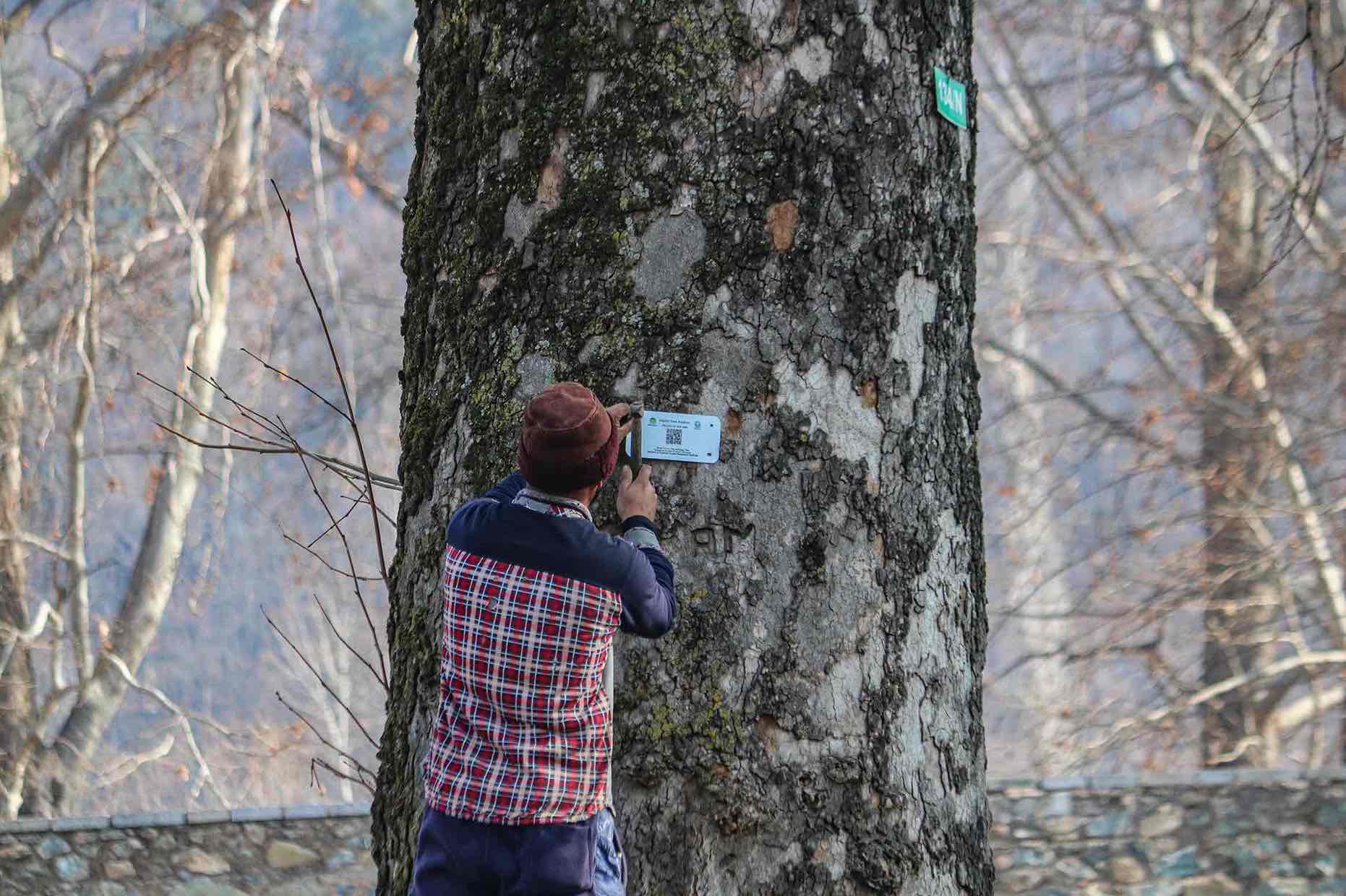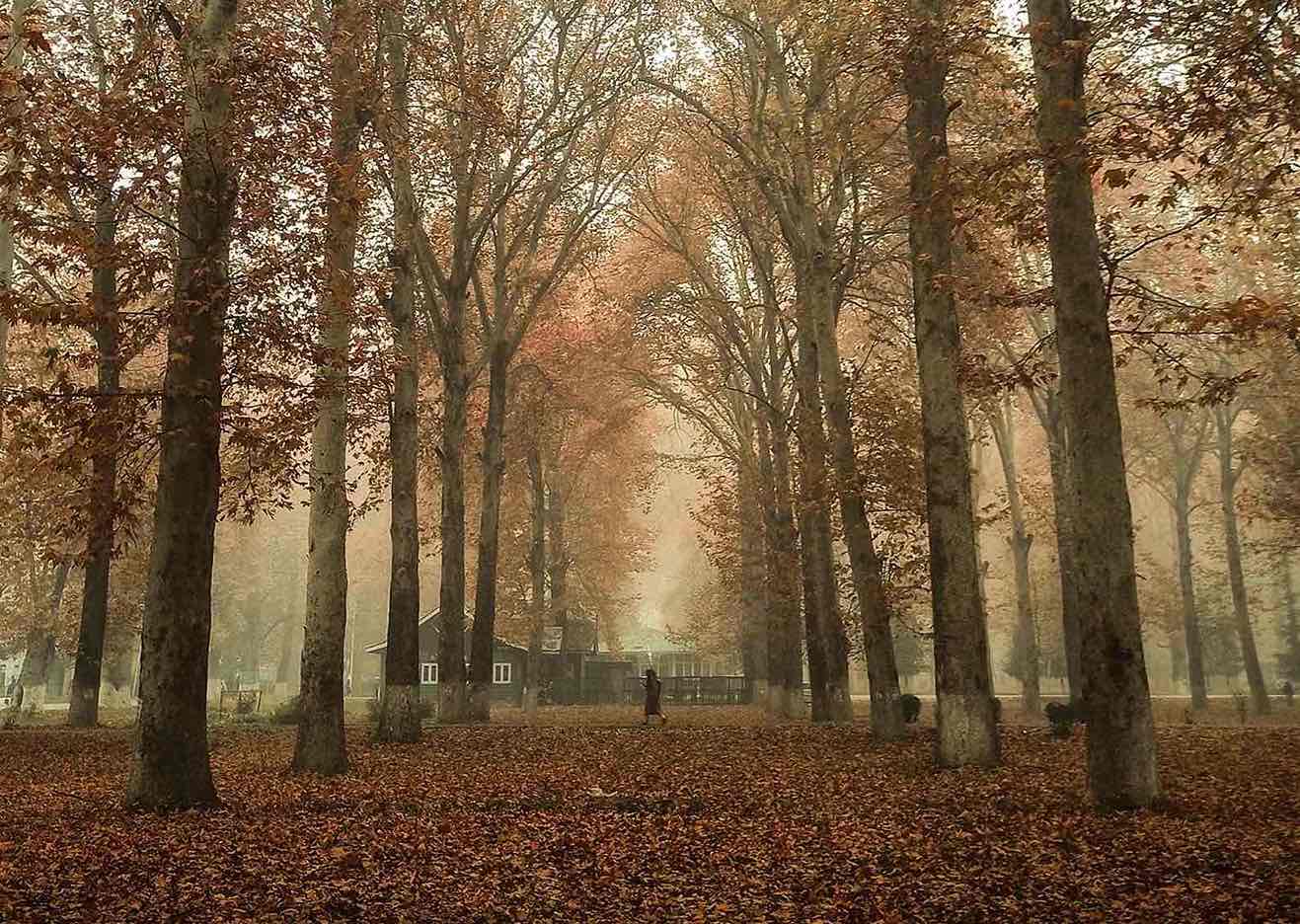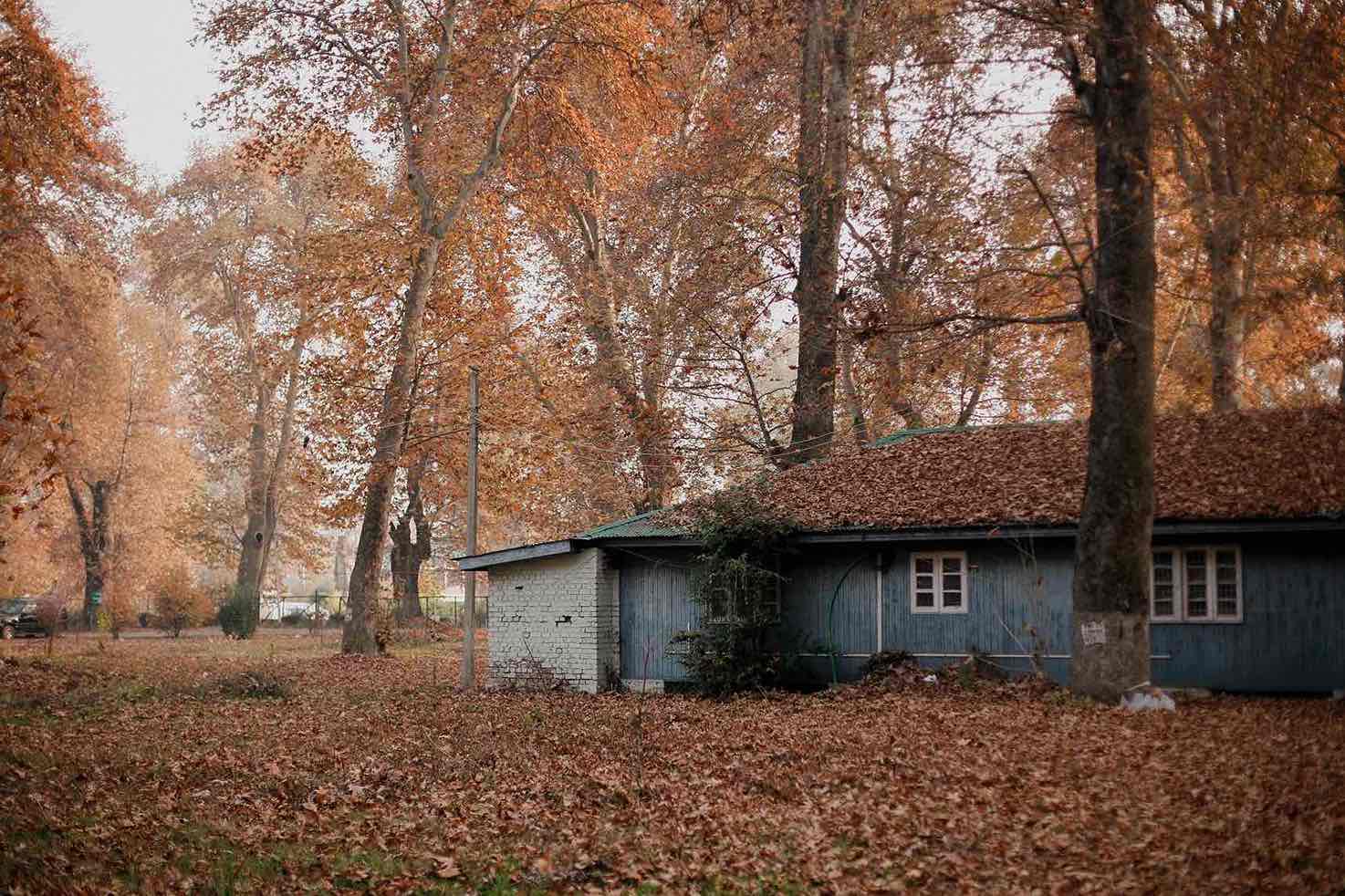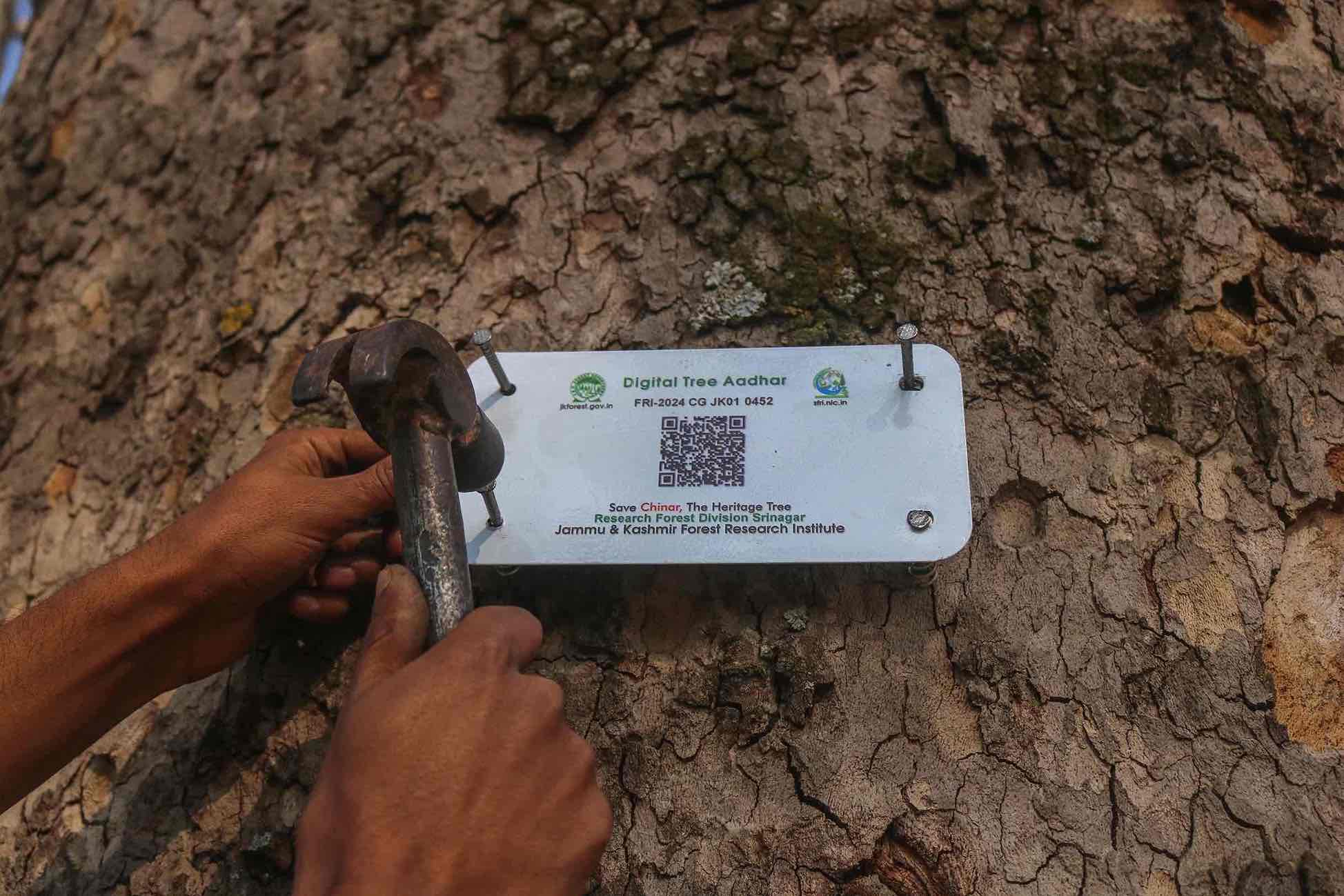Written by Tauseef Ahmad and Sajid Raina
In South Kashmir’s Pulwama district, a group of elderly residents watch with a mix of awe and curiosity as authorities fix geo-tags on the chinar trees in their locality.
The towering chinars, once vulnerable to illegal felling, are now under the digital watch of the administration, marking a new era of conservation — one that leaves no room for tampering.

“Chinar trees are the heritage of the Kashmir valley. Rapid cutting has reduced their numbers drastically. By geo-tagging each tree, we can monitor their health, ensuring their protection and preservation for future generations,” says Syed Tariq, project coordinator at the Jammu and Kashmir Forest Research Institute (JKFRI).
Tariq, who has been working on this project for the last five years, adds that the initiative aims to safeguard chinar trees from the threats of urbanisation and deforestation. As part of the project, around 10,000 chinars have been geo-tagged as of now, he informs.
Kashmir’s chinar roots
Chinar trees, renowned for their longevity and majestic, spreading crowns, offer shade in summer and a breathtaking spectacle in autumn. “These trees take 150 years to reach full maturity and height,” notes Tariq. “Once planted, a chinar tree can last for generations, often remaining until the fourth or fifth.” He adds that these giants can grow up to 30 meters tall, with a trunk circumference of 10-15 metres.
Known locally as ‘Bouin’ (from the Sanskrit word ‘Bhawani’, meaning ‘goddess’), the chinar has deep cultural significance in Kashmir. Chinar trees planted during the Mughal era and the Dogra dynasty, some dating back to the time of Lal Ded, are a testament to this history. Mughal emperor Akbar, for example, planted an estimated 1,200 trees at Naseem Bagh, near Dal Lake and the Hazratbal shrine, a portion of which still stands today.

Central Kashmir’s Ganderbal district boasts the world’s third-largest chinar tree, with a remarkable 74-foot girth. One of Kashmir’s oldest, estimated to be around 650 years old, graces the outskirts of Srinagar.
“While most chinar trees are found in the Kashmir valley,” Tariq explains, “they also grow in the Chenab and Pir Panjal regions of Jammu.”
Heritage at stake: Dying chinars
However, these autumn spectacles are facing a severe decline. Data suggests a dramatic reduction, from 42,000 trees in 1970 to between 17,000 and 34,000, today. This loss is evident even in celebrated locations like Srinagar’s Shalimar Garden, a Mughal-era masterpiece famed for its vibrant fall foliage. Local resident Shabir Ahmad tells The Better India that Shalimar’s once-majestic chinars, now numbering around 220, are succumbing to drought and decay.
“Over the past decade, the decline has been stark,” observes Aarif Sheikh, a resident of Ganderbal. He explains the legal protections afforded to these trees, requiring approval from the Divisional Commissioner for felling, even on private land, yet acknowledges that illegal felling persists.
Even Naseem Bagh, where Mughal emperor Akbar planted over 1,100 chinars, has suffered immense losses. Gardener Nazir Ahmad reports a sharp decline, with only 700 trees remaining, according to 2021 data from the Jammu and Kashmir Forest Department. Infrastructure expansion and pest infestations, exacerbated by a lack of proper care before geo-tagging, have taken a heavy toll.

Environmentalists also attribute this crisis in part to climate change. The Himalayas’ fragile ecosystem is highly susceptible to shifting weather patterns. A 2022 study revealed that between 1980 and 2020, Kashmir’s maximum and minimum temperatures increased by 2.00°C and 1.10°C, respectively, while precipitation decreased.
The consequences are significant. “Chinars are crucial for preventing soil erosion,” explains environmentalist Raja Muzaffar Bhat. “Their deep roots act as anchors, and they are vital carbon sinks. During the 2014 floods, areas with chinar trees were significantly less affected by soil erosion.”
Using tech to save Kashmir’s chinar trees
In 2021, the J&K Forest Department decided to take an innovative step towards protecting these iconic trees — a unique ‘aadhar identity’ for every single chinar in the Kashmir valley. As part of the project, chinar trees are being geotagged with scannable QR plates, and are being monitored and safeguarded using cutting edge tech.
“Using ultrasonography-based (USG) gadgets, we can assess the health and risk levels of each chinar, eliminating the need for manual evaluation,” Tariq explains. This technology allows for early detection of vulnerabilities and targeted interventions.
The J&K Forest Department, spearheading the campaign, is utilising a Geographical Information System (GIS) to create a comprehensive database. “This initiative will be crucial in protecting chinar trees from the threats of urbanisation and deforestation,” says Tariq.

Scanning the QR code provides instant access to 35 data points, Tariq informs. According to the Forest Research Institute (FRI) census, 28,500 trees have been tagged so far, with the total expected to reach 32,500 by the end of March 2025. Ten thousand more trees are expected to be geotagged in the near future.
“This detailed record will enable us to conduct ongoing research, identify trees requiring specific treatments, and provide timely care to prevent further decline,” explains Tariq. “We plan to conduct more research in the future to ensure the health of these trees and find if any tree needs intervention,” he adds.
While the survey on the geo-tagging initiative’s success is still ongoing, between 2021 and today, Tariq says that there have been no illegal felling of chinar trees.
Edited by Arunava Banerjee; All images courtesy Athar Nagar
##QA-TP1##
